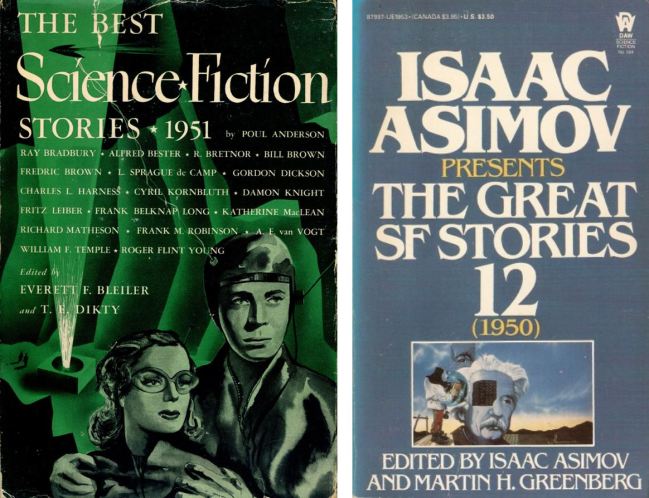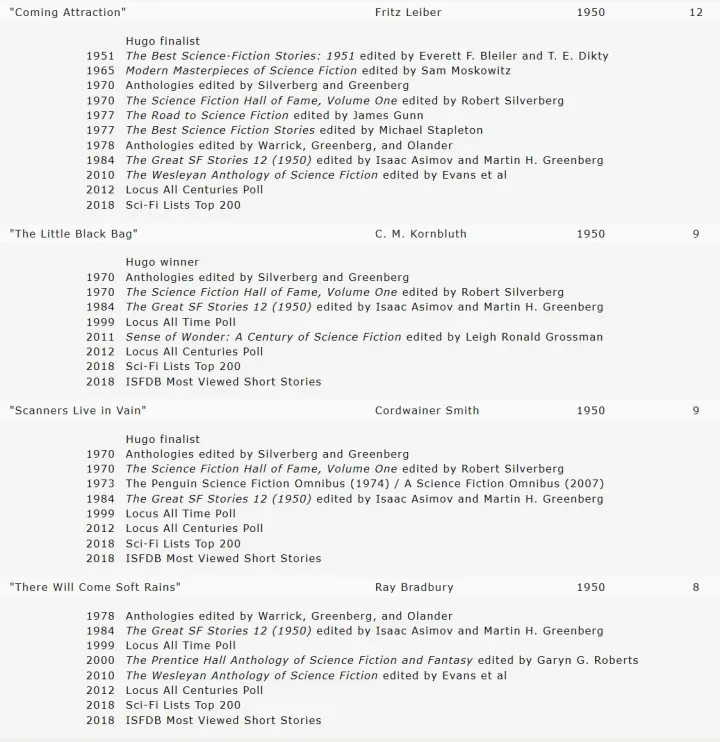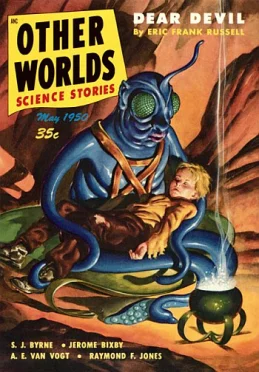
1950 was a great year for SF short stories. Along with 1966 and 1982, they tie for having the most stories in one year on the updated Classics of Science Fiction Short Stories. Four memorable stories in one year is outstanding since many years have none, and only 1-2 is common. Also, before I read the two anthologies pictured above I was already familiar with 7 of the stories. That’s the most since I started this reading project of systematically reading through the best-SF-of-the-year anthologies starting with 1939.
1950 represents an evolution in mature science fiction writing. It also reflects the influence of magazines besides Astounding Science Fiction. The old timers in my youth considered the 1940s the Golden Age of Science Fiction, but for my generation, the 1950s is our Golden Age. I’m very excited to finally arrive in 1950 and look forward to reading through the decade.
In 1951 Everett F. Bleiler and T. E. Dikty selected the following 1950 science fiction short stories for The Best Science Fiction Stories 1951:
- “The Santa Claus Planet” by Frank M. Robinson (original)
- “The Gnurrs Come from the Voodvork Out” by Reginald Bretnor (F&SF)
- “The Mindworm” by C. M. Kornbluth (Worlds Beyond)
- “The Star Ducks” by Bill Brown (F&SF)
- “Not to Be Opened” by Peter Grainger (as Roger Flint Young) (Astounding)
- “Process” by A. E. van Vogt (F&SF)
- “Forget-Me-Not” by William F. Temple (Other Worlds)
- “Contagion” by Katherine MacLean (Galaxy)
- “Trespass!” by Poul Anderson and Gordon R. Dickson (Fantastic Story Quarterly)
- “Oddy and Id” by Alfred Bester (Astounding)
- “To Serve Man” by Damon Knight (Galaxy)
- “Summer Wear” by L. Sprague de Camp (Startling Stories)
- “Born of Man and Woman” by Richard Matheson (F&SF)
- “The Fox and the Forest” by Ray Bradbury (The Illustrated Man)
- “The Last Martian” by Fredric Brown (Galaxy)
- “The New Reality” by Charles L. Harness (Thrilling Wonder)
- “Two Face” by Frank Belknap Long (Weird Tales)
- “Coming Attraction” by Fritz Leiber (Galaxy)
In 1984 Isaac Asimov and Martin H. Greenberg picked these stories for The Great SF Stories 12 (1950):
- “Not with a Bang” by Damon Knight (F&SF)
- “Spectator Sport” by John D. MacDonald (Thrilling Wonder)
- “There Will Come Soft Rains” by Ray Bradbury (Collier’s)
- “Dear Devil” by Eric Frank Russell (Other Worlds)
- “Scanners Live in Vain” by Cordwainer Smith (Fantasy Book)
- “The Little Black Bag” by C. M. Kornbluth (Astounding)
- “Enchanted Village” by A. E. van Vogt (Other Worlds)
- “Oddly and Id” by Alfred Bester (Astounding)
- “The Sack” by William Morrison (Astounding)
- “The Silly Season” by C. M. Kornbluth (F&SF)
- “Misbegotten Missionary” by Isaac Asimov (Galaxy)
- “To Serve Man” by Damon Knight (Galaxy)
- “Coming Attraction” by Fritz Leiber (Galaxy)
- “A Subway Named Mobius” by A. J. Deutsch (Astounding)
- “Process” by A. E. van Vogt (F&SF)
- “The Mindworm” by C. M. Kornbluth (Worlds Beyond)
- “The New Reality” by Charles L. Harness (Thrilling Wonder)
I’ve bolded the overlap. I’ve often wondered when Asimov and Greenberg made up their anthology did they consider what Bleiler and Dikty had done in the past? The Bleiler/Dikty books would have been rare even back in 1984, so I assume they didn’t. Or did they imagine that one day readers would judge the two books together for what they collectively say about the short science fiction of 1950?
And why did Bleiler and Dikty miss “There Will Come Soft Rains,” “Scanners Live in Vain,” “The Little Black Bag,” and “The Silly Season” which all have become classics since then? Or do later readers discover value in stories that readers back in 1950 missed? “There Will Come Soft Rains” was included in The Martian Chronicles so it was being widely read as Bleiler and Dikty were assembling the volume. “The Little Black Bag” and “Scanners Live in Vain” were included in the first volume of The Science Fiction Hall of Fame in 1970, selected by the popular vote of science fiction writers, so it seems odd they weren’t recognized as instant classics. I think “The Silly Season” is an important miss, but they did include Kornbluth’s “The Mindworm.” Maybe Bleiler/Dikty didn’t want to use two of his stories?
If you look at the 60 short stories from 1950 that’s in our database order by total citations you’ll see both anthologies got most of the most remembered stories. But each anthology also recognized a few classics the other missed. I think the story they both missed which stands out the most is Ray Bradbury’s “The Veldt.” It’s always remembered on fan polls but that’s probably because schools teach it.
Here are the stories that made it to the Classics of Science Fiction Short Stories list:

Notice that the top three stories won Retro Hugo Award for 1951. The only short stories/novelettes the fans voting for the retro Hugo that the two anthologies missed were “The Helping Hand” by Poul Anderson and “Okie” by James Blish. Neither anthology included any of the novella nominations. If you study the citation sources for the above stories you’ll see how each has remained popular in fan polls.
For these four stories, this was at least my fourth reading for each of them since the 1960s. Each time they get better and I notice more details. These stories should be read by any would-be writers wanting models to study. They are rich in ideas, dense with details, yet very told dramatically. These four stories are so obvious and famous that there’s little reason to discuss them. And I think the voters for the 1951 Retro Hugo Award also picked the obvious novella choice: “The Man Who Sold the Moon” by Robert A. Heinlein.
The fun question to ask now: What is the best of the forgotten stories? I’m partial to “Contagion” by Katherine MacLean which I’ve already reviewed separately. I thought it a standout story for the time because MacLean was poking fun at male SF fans and gender issues.
 “Dear Devil” is my favorite Eric Frank Russell story so far in this reading project. It’s about another Martian invasion, but this time a very positive one. Don’t you miss Martians? Sure the story is sentimental and unrealistic, but if you loved the movie E.T. you’ll probably love “Dear Devel.”
“Dear Devil” is my favorite Eric Frank Russell story so far in this reading project. It’s about another Martian invasion, but this time a very positive one. Don’t you miss Martians? Sure the story is sentimental and unrealistic, but if you loved the movie E.T. you’ll probably love “Dear Devel.”
“The New Reality” by Charles L. Harness reminds me somewhat of Greg Egan’s novel Quarantine because it’s about how our ideas of reality shape reality. The story is a gnarly philosophical fantasy about ontology. The story itself is a kind of a mess, lacking in structure and realistic dramatic action, but it’s filled with the kind of ideas that mess with your head, the kind that pot smokers and science fiction fans love.
“The Sack” by William Morrison is not a great story, but it is a fun read. Explorers find an intelligent creature on an asteroid. It is the last of its kind, and it looks like a sack of potatoes. However, the Sack is so smart and willing to answer questions, that humans sell time with it like we do scheduling a supercomputer. The Sack is so effective at answering questions that nations and criminals want to kidnap it. The Sack claims it is always honest, but warns the human questioners that its knowledge might not always be beneficial.
“Misbegotten Missionary” by Isaac Asimov was later renamed “Green Patches” but I like the original name better. Asimov later realized that this story is similar to “Who Goes There?” by John W. Campbell, his mentor. Space explorers visit a planet where all life is part of a single unified consciousness and this lifeform thinks humans are tragically incomplete since they are isolated individuals. The gestalt organism has a way of possessing humans to make them part of their whole. When the Captain of the first space ship lands on this planet and discovers his crew has been infected he blows his ship up. The story is about the second ship returning from the planet with a very clever hitchhiker. Because this tale has more story and less lecture, it’s one of Asimov’s more entertaining tales.
That’s one of the big problems of older science fiction, authors are inspired by far out ideas, but they don’t know how to present them dramatically. Many of these stories in these two anthologies are often interrupted by mini-lectures. That’s why “Scanners Live in Vain” and “Coming Attractions” were such standouts. Each is dense with ideas, but throw off their dazzling concepts as part of the action. They are dramatic and emotional.
Most of the stories in these two anthologies are still entertaining, but I believe most modern readers will find most of the second-string stories slight, clunky, outdated, or primitive. Aficionados of old SF will probably get a kick out of them.

The first two issues of Galaxy, October and November 1950 contains
“Contagion,” “The Last Martian,” “Misbegotten Missionary,” “Coming Attraction,” and “To Serve Man” – four stories for Bleiler/Dikty and three for Asimov/Greenberg. That’s a pretty impressive debut.
The impact of the new magazines F&SF and Galaxy is particularly impressive when you realize they were competing with Astounding’s 12 issues with just 4 and 3 issues respectively.
Off to read 1951 – the year I was born.
James Wallace Harris
Glad you enjoyed this one more than the others.
You like those first three issues of Galaxy better than I did—the only two stories I would have Year’s Bested would be the Leiber and “The Stars are Styx” by Theodore Sturgeon. I would have bought the Asimov for a magazine issue but not the other three. I actively disliked the Knight (dumb joke) and Brown (Silly Season redo) stories. The MacLean was pretty average. I wouldn’t have picked “Silly Season” either (not that good) but would have used “The Mindworm” (and “Bag” from what I remember of it).
I note that the Asimov/Greenberg book only uses three stories from Galaxy, and if Asimov wasn’t the editor that might have been two.
Weird that the Bleiler/Dikty uses an original story—if it was that good, surely he could have sold it elsewhere.
The Asimov/Greenberg looks the stronger volume from what I know at the moment.
Looking forward, the next volumes will be missing Ray Bradbury’s excellent “The Fireman”. Much, much better than “Fahrenheit 451”, and I suggest you dig it out.
LikeLike
I thought both the Damon Knight stories were dumb jokes. I thought all the stories other than the four on the CSF list had varying degrees of problems. “Contagion” is a weakly constructed story, but it’s fun because of MacLean’s poking fun of gender issues. “Silly Season” is not a well-developed story either, but it has such a wonderfully cynical view.
I don’t think I could fill an annual anthology with stories I completely admired.
LikeLike
Hi I thought I would chip in. I have to say Knight has not impressed me, the stories I have read seem, forced? contrived? maybe, as though he was trying to reach some predetermined punchline, I read a Fredric Brown story Earthmen Bearing Gifts recently that was the same and I was not happy. Mindworm left me cold. As for missing “There Will Come Soft Rains,” “Scanners Live in Vain,” “The Little Black Bag,” all are stories that have, in my mind held up fairly well. Leonard Nimoy reading “There Will Come Soft Rains,” (available on youtube) is wonderful. Scanners and Smith in general don’t seem as popular ass I think, they should be. He took a different approach to SF and the future, one that I think aligns more with some the work that is being produced today than a lot of stories written by the Astounding stable of writers Campbell supported. And Dear Devil, love it, I found a copy of the Other Worlds with this cover in my local used bookstore and was really pleased, It was on my list for quite a while.
LikeLike